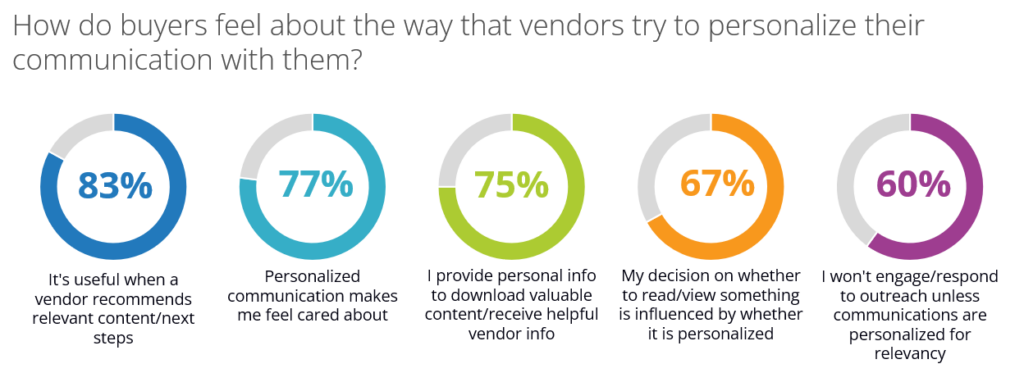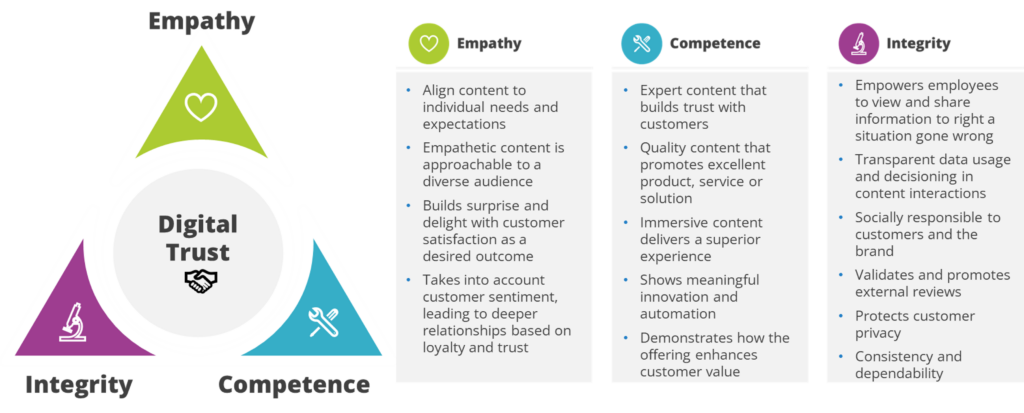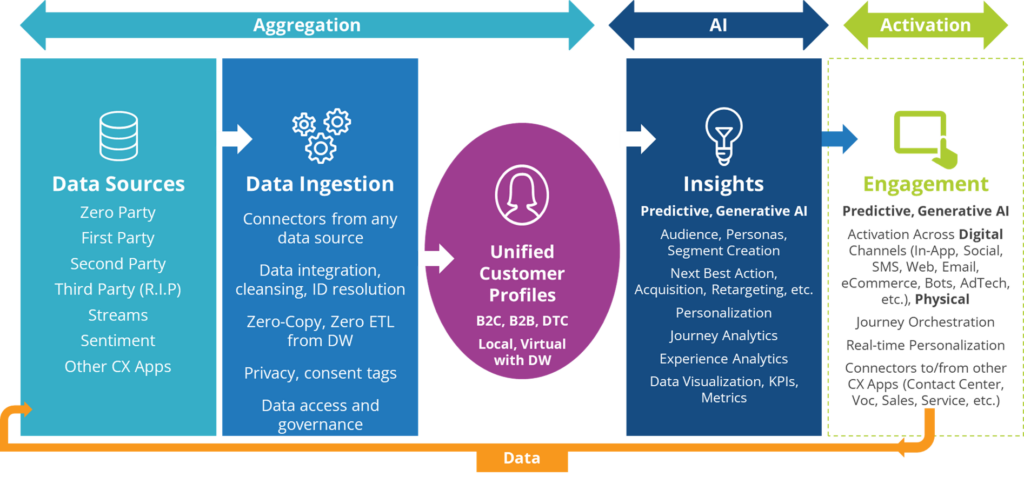What do customers expect from brands? They expect contextually relevant experiences. This should manifest throughout digital journeys with their preferred brands regardless of the business model. They value relevant content, next steps, and contextual awareness throughout their journeys. For brands, contextual awareness means that they can communicate to customers that the brand understands the nuances of each customer interaction, with every communication conveyed in a sensitive and acceptable way from the customer’s perspective.
Most customers (B2C) or buyers (B2B) will not engage with vendors when the communication is not contextually aware. The decision to view content or communications (or not) is based on brands meeting their expectations (or not). B2B buyers are also B2C customers in their personal lives and carry over high expectations of contextual awareness from consumer brand interactions into decisions made in their work lives. IDC’s 2023 B2B Technology Buyer Survey responses prove this point.

The experiences that customers expect from brands are, increasingly, all digital. Online transactions have become the majority; among Gen Z, 67% lean toward an online-first mentality, while younger millennials are at 75%. Digital communications, delivered with contextual awareness at the right moment in time, allow brands to demonstrate cognitive empathy, competence, and integrity which together create digital trust.
Callout: With digital engagement dominating engagement mode, the use of contextually relevant content, informed by unified customer data, will be imperative for brands to maintain, nurture, and grow customer relationships.

The challenge for brands, across all go-to-market (GTM) models, is delivering the digital experience reality that customers expect. Meeting customer expectations is a fast-moving target that is difficult to meet without a tremendous amount of data and insights. In IDC’s latest monthly survey (October 2023), less than one-half of respondents (47%) say they are mostly or entirely digital businesses (leaders), with the rest (53%) reporting that they are somewhat or not digital businesses (followers). CEOs recognize that proficiency in digital strategy is almost as important as proficiency in business strategy (46% vs. 49% in our 2023 survey).
The Three Technologies
What are the CX technology investments that your brand should be making to aspire to or maintain leadership in CX in your markets?
- Customer data platforms (CDPs), which create and continually update unified customer data profiles, are the basis for understanding customers’ needs in their interactions with your brand. CDPs provide a unified and connected data fabric that delivers a continual understanding of customer context from previous interactions combined with current, real-time interactions. 75.2% of IDC survey respondents plan to increase this area of CX technology spending over the next 12 months.
- Predictive AI (AI, ML, advanced analytics), which delivers active learning from customer insights in the data by gathering customer intelligence, generating and analyzing insights, and evaluating actions based on real-time feedback from each engagement. Sentiment measurement also plays a significant role in active learning for contextual awareness, as real-time sentiment sensing can be an early warning signal for positive or negative changes in customer behavior. 58.1% of survey respondents plan to maintain or increase this area of CX technology spending over the next 12 months.
- Generative AI, which is already being used in marketing, sales, and service applications to deliver interactions with individualized content in digital communications including emails and web pages with automatic branding elements to maintain communications consistency. Generative AI is also improving customer support interactions by adding organizational knowledge bases to improve digital assistant and agent quality. One-third of organizations are already investing significantly in Generative AI for training, acquisition, and implementation of Generative AI-enhanced software and consulting services in the next 18 months. Customer support, marketing, and sales organizations report their top Generative AI business focus is improved customer satisfaction, with an average response of 58%.
How do these three technologies interact with each other? Here is one example, with CDPs performing data aggregation and customer context, Predictive AI insights, and Generative AI activation which is the personalized interaction sent to the customer through a communication channel that is most likely digital but could also be physical (in-store).

What business outcomes are possible using these three technologies?
- A global technology brand achieved a 5x lift in conversions by using AI-driven insights to reallocate media spend, with 96% AI accuracy for predicted user behavior.
- A global pharmaceutical brand achieved a 40% increase in cosmetics sales due to better personalization, with a 40% reduction in cost per acquisition (CPA) for completed purchases.
- A global automobile brand experienced a 300%+ increase in advertising click-through rates (CTRs), a 2.5x increased conversion rate in the top customer segment, with a 38% reduction in cost per acquisition (CPA).
The business outcomes for Generative AI will be more available with increased adoption of use cases in production. IDC’s C-suite tech survey results provide a preview of the top expected business outcome areas in these business groups:
- CX, Service and Support: improved customer satisfaction (64.7%)
- Marketing: revenue growth (57.2%)
- Sales: increased operational efficiency and employee productivity (69.9%)
A Glimpse into the Future
In this blog, we have focused on three technologies that increase insight, trust, and engagement with your customers now. Let’s look into the future with IDC FutureScape 2024 predictions that are based on the technologies described in this blog.
- Customer data platforms will deliver high-quality data for predictive AI and GenAI, activating 80% of real-time personalized customer interactions at scale for G2000 firms with 4x engagement gains by 2026.
- By 2025, 65% of G1000 companies will adopt trust-based marketing programs, harness greater value from zero- and first-party data, and improve marketing profitability by 50%.
- Pervasive sentiment and intent AI will propel 55% of G1000 firms to conduct all marketing journeys as real-time, two-way conversations by 2025, improving leads to purchase conversions by 40%.
Is your firm future-proofed to achieve the outcomes from these predictions? If you use the three technologies discussed here, you can confidently answer – Yes! If you don’t have these technologies, and you see your firm as a digital follower – Watch Out! Your customers, revenue, and market share are at risk from your competitors who are digital business leaders.




